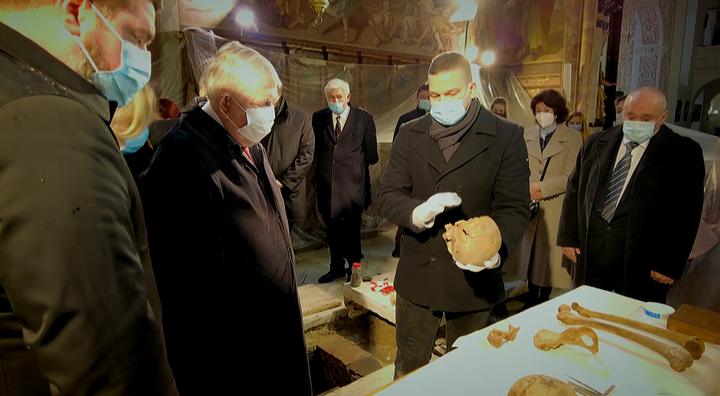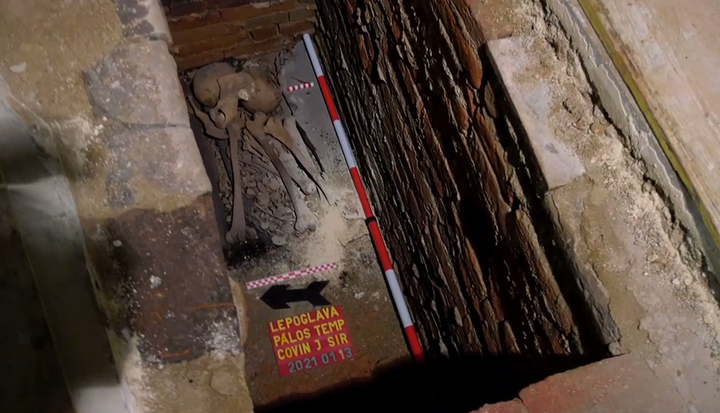Tracing King Matthias
Article on the significance of the identification of the Hunyadi family published in weekly Demokrata. Having isolated the DNA samples in the laboratory of the Institute for Hungarian Studies, the DNA of the Corvinus family can be identified after that of the Árpád Dynasty.
The remains of King Matthias Corvinus can be finally buried with dignity in a national shrine. The scientists of the Institute for Hungarian Studies will be able to identify the king’s earthly remains after they have identified the male-inherited gene sequence of his son, János Corvinus. With this, the dignified and respectful burial of the king’s remains will become possible.

Miklós Kásler, Minister of the Ministry of Human Capacities spoke about the extraordinary opportunity for exploring and restoring our national past and identity in a short video on the Internet. Minister Kásler declared at the resting place of JánosCorvinus buried in 1504 and his son, Kristóf Corvinus in the Pauline Monastery in Lepoglava, Croatia that the identification of the remains of King Matthias Corvinus would become possible if the scientists can identify the male-inherited Y-chromosome DNA haplogroup. King Matthias was originally interred in the ossuary of the Royal Basilica of Székesfehérvár where 15 Hungarian rulers rest in a common grave. After the identification, the dignified burial of our great king will become possible in a national shrine.
Archaeogenetics, this relatively new discipline may also reveal the real origin of the Hunyadi family, legends of many folk tales that will be a considerable step forward to clarifying the ambiguous chapters of Hungarian history. Last year, with the assistance of the Institute for Hungarian Studies, researchers were able to reveal the paternal origin of the Árpád Dynasty based on genome sequencing of DNA derived from the skeletal remains of the Hungarian King Béla III buried in Matthias Church, Budapest. From these data it was established that the genetic origins of the Árpád Dynasty can be traced back to Bactria, an ancient region in central Asia 5000 years ago, the present territory of Afghanistan.
All fair-minded Hungarians are enthusiastic about the possibility of the dignified reburial of the earthly remains of King Matthias and the scientific identification of the origin of his family. Unfortunately, it is typical of the twisted Hungarian political landscape that this sensational achievement has been received with a puzzling lack of discussion and dissent. For example, Népszava, daily newspaper reported about the news under the headline: Minister responsible for health fantasizes about the origin of the Hunyadi family in the middle of an epidemic. Thus, scientific research is fantasising according to the far left, anti-Hungarian daily. It would follow logically that the origin of the Hunyadi family is completely irrelevant for them and the fact that King Matthias is resting in a mass grave does not bother them, either. Their statement speaks for itself but still it would be more straightforward if they published the obvious fact on their cover page that Népszava is completely insensitive to Hungarian history and to every issue that is important to our nation.

Compared to this, it is almost subsidiary that the Bolshevik daily – with its usual deep-rooted shiftiness – tries to give the impression that Miklós Kásler, minister focuses his time on stupidities instead of handling the epidemic. Minister Kásler is the head of the Ministry of Human Capacities whose portfolio also encompasses culture. History is the organic part, moreover the basis of culture. At least, it is in Hungary. And this is exactly what bothers Népszava. The anti-Hungarian propaganda paper is part of a system that has been consistently trying to destroy the national identity of Hungarians for over a century. Experts interviewed on 21 January in the news on ATV neither seemed to be too enthusiastic; Gergely Buzás, archaeologist questioned the significance of the excavation and Richárd Horváth, historian of the Faculty of Humanities of the Loránd Eötvös Research Network diminished the historic role of King Matthias and his age by stating that the king was good at marketing.
Considering these circumstances, the serious commitment of the Hungarian government and the Institute for Hungarian Studies cannot be over-emphasized. Our weekly turned to the interdisciplinary research institute established on the initiative of Miklós Kásler for further details.
King Matthias was originally buried in 1490 in the Coronation Cathedral in Székesfehérvár but the basilica was ravaged and the royal tombs were despoiled during the Ottoman occupation that started in 1543. Later, the skeleton remains were interred in ore caskets without inscriptions and names.
The remains of King Matthias are among the nearly 600 bone remains. The identification of the genetic pattern of János Corvinus is a sure way of identifying King Matthias. This is partly the reason why Miklós Kásler had been intensely and successfully strengthening the Croatian-Hungarian cultural policy and church relations and cooperative partnerships in the field of culture and history. An important step in the process was the opening of the exhibition “Ars et Virtus – Croatia – Hungary. 800 Years of Common Heritage” in Zagreb last September where in his opening lecture on history the minister informed the Croatian partners that the Institute for Hungarian Studies is professionally responsible for the extraction of samples from the Corvinus graves in Lepoglava.
Gábor Horváth-Lugossy, Director General of the interdisciplinary research institute sent a letter to the Varasd Diocese in Croatia, the responsible Croatian ministry and the institute prepared the research plan that was accepted by the Croatian partners. Diplomacy also played an important role in the cooperation, Csaba Demcsák, Hungarian Ambassador to Zagreb held successful mediations between the parties several times.
Finally, the excavation took place this January, where – as it was reported by Miklós Makoldi, director of the Research Centre for Archaeology of the Institute for Hungarian Studies on the spot – a small Baroque wooden casket was found with the inscriptions: Joannes Corvinus and Christoforus Corvinus. After the extraction of the bone remains and the skeletons of King Matthias’ son and grandson, Endre Neparáczki, director of the Research Centre for Archaeogenetics of the Institute for Hungarian Studies immediately started to take samples. Then the bones were replaced in their resting place and the parish priest of the Pauline Monastery of Lepoglava re-consecrated the closed grave.
- As the DNA was isolated in the laboratory of the Institute for Hungarian Studies, the international debate on the origin of János Hunyadi and Matthias I can be finally concluded as soon as the City Council of Székesfehérvár gives permission for the opening of royal graves there because this is the last authorization to be obtained. – highlighted Gábor Horváth-Lugossy the historical significance of the events.
The research will conclude with a joint international, Hungarian-Croatian scientific publication. The Director General of the Institute for Hungarian Studies highlighted that the helpfulness and cooperation of the Croatian partners has been exemplary even at a European level. The negotiations and correspondence have been swift, effective and supportive during the whole process. Not it is up to us, Hungarians.
HUNGARY / 01. 02. 2021.